Vietnamese clothing
Vietnamese clothing is the traditional style of clothing worn in Vietnam.
| Part of a series on the |
| Culture of Vietnam |
|---|
| History |
| People |
| Languages |
| Cuisine |
| Festivals |
| Literature |
|
Music and performing arts |
|
Media
|
| Sport |
|
Monuments |
|
Symbols
|
|
History
For centuries, peasant women typically wore a halter top (yếm) underneath a blouse or overcoat, alongside a skirt (váy). It was up to the 1920s in Vietnam's north area in isolated hamlets wear skirts were worn.[1] Before Nguyễn dynasty, the cross-collared robe (áo giao lĩnh) was worn popularly,[2][3] like the other countries in the Sinophere including China (see Ancient Chinese clothing), Japan (Japanese clothing) and Korea (Korean clothing).
Baiyue period
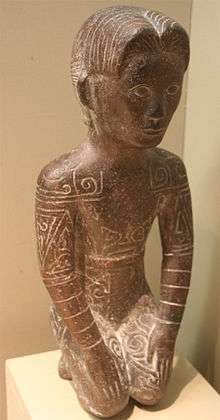
The Han Chinese referred to the various non-Han "barbarian" peoples of north Vietmam and southern China as "Yue" (Viet) or Baiyue, saying they possessed common habits like adapting to water, having their hair cropped short and tattooed. The Han also said their language was "animal shrieking" and that they lacked morals, modesty, civilization and culture.[4][5]
During the Vietnamese Trung sisters' rebellion (Khởi nghĩa Hai Bà Trưng - Đánh đuổi Tô Định) against the Han dynasty's First Chinese domination of Vietnam, the Han Chinese administrator of Jiaozhi (Vietnam), Sū Dìng (蘇定 Tô Định) only managed to escape to China and avoid being discovered by the Vietnamese rebels by shaving his long hair to blend in with Vietnamese along the way since shaving hair was a common custom of Vietnamese men of that era but not of Chinese men as Nguyễn Khắc Thuần recorded.[6]
Lý dynasty to Trần dynasty (1009–1400)
Vietnamese wore a round neck costume, which made from 4 part of cloths called áo tứ điên.[7] Both men and women could wear that. Besides, there are other types such as: áo giao lĩnh (cross-collared robe). The garments "áo" (áo is for the upper part of body) is over knee length, round neck garments have buttoned, when cross-collared robe tied to the right. The ambassador Zhao Rukuo (Triệu Nhữ Thích) commented that the dress style of Vietnamese people at that time (1125) was not much different from the Chinese in Song dynasty.[7]

Short hair or shaven head had been popular in Vietnam from the ancient period. Vietnamese men had shaven head or short hair during Trần dynasty.[8] Evidences are in the painting "The Mahasattva Trúc Lâm Coming Out of the Mountains" which drew Trần Nhân Tông and men in Trần dynasty[9] as well as the Chinese encyclopedia "Sancai Tuhui" from 17th century. That conventionality had been popular until the Fourth Chinese domination of Vietnam.
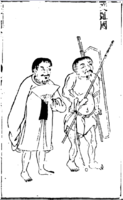
 Trần dynasty clothings as depicted in "The Mahasattva Trúc Lâm Coming Out of the Mountains".
Trần dynasty clothings as depicted in "The Mahasattva Trúc Lâm Coming Out of the Mountains".
Fourth Chinese domination of Vietnam
When Han Chinese ruled the Vietnamese in the Fourth Chinese domination of Vietnam due to the Ming dynasty's conquest during the Ming–Hồ War they imposed the Han Chinese style of men wearing long hair on short haired Vietnamese men. Vietnamese were ordered to stop cutting and instead grow their hair long and switch to Han Chinese clothing in only a month by a Ming official. Ming administrators said their mission was to civilized the unorthodox Vietnamese barbarians.[10] The Ming dynasty only wanted the Vietnamese to wear long hair and to stop teeth blackening so they could have white teeth and long hair like Chinese.[11]
Later Lê dynasty (1428–1789)
After ending the Fourth Chinese domination of Vietnam, people of Đại Việt started to rebuild the country. Because the Ming invaders had destroyed almost documents from the previous dynasties of Vietnam, the government had to reconstruct, reused old clothes from previous dynasties, mostly Trần dynasty. In 1435 emperor Lê Thái Tổ had appointed the high-rank mandarin Nguyễn Trãi to find the new costume adoption, but Nguyễn Trãi had failed on a debating with another mandarin name Lương Đặng, who strongly suggests adopting Ming clothing.[12] Since November 1437, the new dress regulation for emperor and whole bureaucracy system was adopted, which resembled from the Ming dynasty, included for every commune, district to province quan in the country. High-rank mandarins from 3rd to 1st wore red robes, medium-rank mandarin from 5th to 4th wore green robes, and all lowers wore blue robes, and all Mandarins wore mũ Ô Sa (a Vietnamese longer variant Wushamao 烏紗帽).[13] During the first period, Lê emperors wore the mũ Xung Thiên (Yishanguan 翼善冠), which was sent from Ming Dynasty, for examples, in October 1442, Lê Nhân Tông received mũ Xung Thiên from Emperor Yingzong of Ming.[14] During this period, cross-collared robe called áo giao lĩnh was popular among civilians.[15][16][17] The Lê dynasty encouraged the civilians back to the traditional customs: have teeth blackening as well as have hair cut and head shaven. A royal edict was issued by Vietnam in 1474 forbidding Vietnamese from adopting foreign languages, hairstyles and clothes like that of the Lao, Champa or the "Northerners" which referred to the Ming. The edict was recorded in the 1479 Complete Chronicle of Dai Viet of Ngô Sĩ Liên.[18]
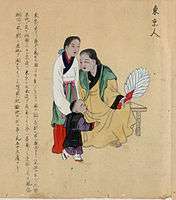 Two women and a child in Tonkin around 1700s.
Two women and a child in Tonkin around 1700s.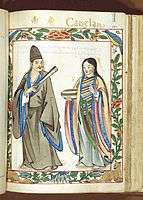 Vietnamese nobleman and wife from Quảng Nam in 1595.
Vietnamese nobleman and wife from Quảng Nam in 1595. Vietnamese nobleman and wife from Hải Môn harbor in 1595.
Vietnamese nobleman and wife from Hải Môn harbor in 1595.
Before 1744, people of both Đàng Ngoài (the north) and Đàng Trong (the south) wore áo giao lĩnh with thường (a kind of long skirt). Both male and female had loose long hair.
 A servant woman and a mandarin of the Lê dynasty.
A servant woman and a mandarin of the Lê dynasty. Portrait of Nguyễn Quý Đức in Đàng Ngoài. He was wearing a cross-collared robe (áo giao lĩnh) and had loose long hair.
Portrait of Nguyễn Quý Đức in Đàng Ngoài. He was wearing a cross-collared robe (áo giao lĩnh) and had loose long hair.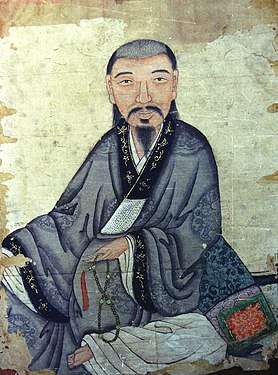 Portrait of Prince Tôn Thất Hiệp (Nguyễn Phúc Thuần) of Đàng Trong from the 17th century. He wears a cross-collared robe (áo giao lĩnh).
Portrait of Prince Tôn Thất Hiệp (Nguyễn Phúc Thuần) of Đàng Trong from the 17th century. He wears a cross-collared robe (áo giao lĩnh).- Portrait of Lady Minh Nhẫn Mrs. Bùi Thị Giác (1738-1805), Thai Binh province of Đàng Ngoài in Revival Lê dynasty.
In 1744, Lord Nguyễn Phúc Khoát of Đàng Trong (Huế) decreed that both men and women at his court wear trousers and a gown with buttons down the front. That the Nguyen Lords introduced ancient áo dài (áo ngũ thân). The members of the Đàng Trong court (southern court) were thus distinguished from the courtiers of the Trịnh Lords in Đàng Ngoài (Hanoi),[19][3] who wore áo giao lĩnh with long skirts.[17]
- Paintings about Đàng Ngoài
.jpg) Đàng Ngoài in Revival Later Lê dynasty: men were wearing đinh tự hats on their heads.
Đàng Ngoài in Revival Later Lê dynasty: men were wearing đinh tự hats on their heads.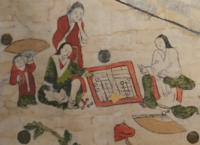 "Giảng học đồ" (講學圖 - Teaching): Đàng Ngoài in 18th century, Hanoi museum of National History;
"Giảng học đồ" (講學圖 - Teaching): Đàng Ngoài in 18th century, Hanoi museum of National History;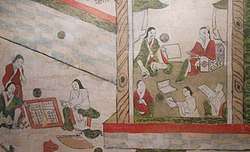 "Giảng học đồ" (講學圖 - Teaching): Scholars and students wear cross-collared robe (áo giao lĩnh);
"Giảng học đồ" (講學圖 - Teaching): Scholars and students wear cross-collared robe (áo giao lĩnh); "Giảng học đồ" (講學圖 - Teaching): Adults had loose and long hair.
"Giảng học đồ" (講學圖 - Teaching): Adults had loose and long hair.
Nguyễn dynasty (1802–1945)
Áo ngũ thân (ancient áo dài which made of 5 parts of clothes) with standing collar and trousers was forced on Vietnamese people by the Nguyễn dynasty. "Váy đụp" (skirt) was banned.[20] However, it was up to the 1920s in Vietnam's north area in isolated hamlets where skirts were worn.
The Vietnamese had adopted the Chinese political system and culture during the 1,000 years of Chinese rule so they viewed their surrounding neighbors like Khmer Cambodians as barbarians and themselves as a small version of China (the Middle Kingdom).[21] By the Nguyen dynasty the Vietnamese themselves were ordering Cambodian Khmer to adopt Han Chinese culture by ceasing "barbarous" habits like cropping hair and ordering them to grow it long besides making them replace skirts with trousers.[22] Han Chinese Ming dynasty refugees numbering 3,000 came to Vietnam at the end of the Ming dynasty. They opposed the Qing dynasty and were fiercely loyal to the Ming dynasty. Vietnamese women married these Han Chinese refugees since most of them were soldiers and single men. Their descendants became known as Minh Hương and they strongly identified as Chinese despite influence from Vietnanese mothers. They did not wear Manchu hairstyle unlike later Chinese migrants to Vietnam during the Qing dynasty.[23]
Áo giao lĩnh still be used during Nguyễn dynasty. Besides, the Nguyễn dynasty created áo nhật bình, khăn vấn.
 Men of Nguyễn dynasty in formal attire
Men of Nguyễn dynasty in formal attire Empress Nam Phương on her wedding day, 1934
Empress Nam Phương on her wedding day, 1934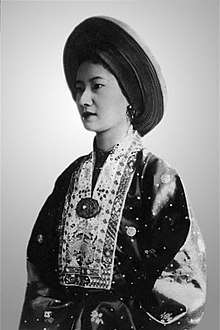 Empress Nam Phương wearing áo nhật bình and khăn vành dây
Empress Nam Phương wearing áo nhật bình and khăn vành dây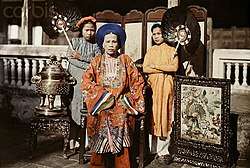 Princess Mỹ Lương wearing red áo nhật bình and dark blue khăn vành dây
Princess Mỹ Lương wearing red áo nhật bình and dark blue khăn vành dây
The áo dài was created when tucks which were close fitting and compact were added in the 1920s to this Chinese style. The Chinese clothing in the form of trousers and tunic were mandated by the Vietnamese Nguyen government. The Chinese Ming dynasty, Tang dynasty, and Han dynasty clothing was referred to be adopted by Vietnamese military and bureaucrats by the Nguyen Lord Nguyễn Phúc Khoát (Nguyen The Tong) from 1744.[3]
- Artifacts of Nguyễn dynasty
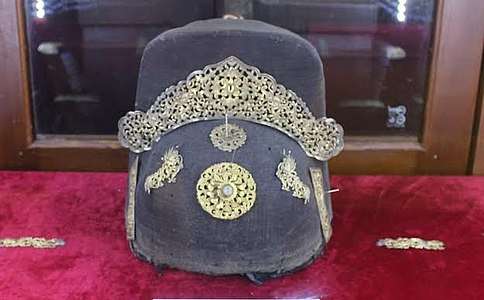 19th century Phốc Đầu cap, with ornamented gold Kim Bác Sơn
19th century Phốc Đầu cap, with ornamented gold Kim Bác Sơn Mandarin boots and shoes. Gilded metal, Nguyễn dynasty, 19th-early 20th century[lower-alpha 1]
Mandarin boots and shoes. Gilded metal, Nguyễn dynasty, 19th-early 20th century[lower-alpha 1]- Uniforms of students of the imperial academy
- Court attires of Nguyễn Dynasty
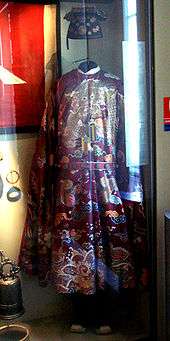 Ceremonial dress of Marshall Nguyễn Tri Phương[lower-alpha 2]
Ceremonial dress of Marshall Nguyễn Tri Phương[lower-alpha 2]
Examples of garments
- Áo giao lĩnh – cross-collared robe were popular in Lê dynasty and the earlier dynasties.
- Áo tứ thân – a four-piece woman's dress, áo ngũ thân in 5-piece form.
- Yếm – woman's undergarment.
- Áo gấm – formal brocade tunic for government receptions, or áo the for the man in weddings.
- Đinh Tự, Phốc Đầu, the standard conical nón lá and lampshade nón quai thao (Headware)
- Khăn vấn – kind of garment wear on head of Vietnamese people which was popular used from Nguyễn dynasty.
- Áo tràng Phật tử – typically shortened to "áo tràng" it is a robe worn by Upāsaka and Upāsikā in Vietnamese Buddhist temples.[lower-alpha 3]
- Áo dài – the typical Vietnamese formal girl's dress
- Áo bà ba – two-piece ensemble for men and women[24]
- Áo bà ba (black pyjamas), dép lốp (rubber sandals), the rural khăn rằn scarf. (Clothing associated with the Vietnam war)
Twentieth century
From the twentieth century onward Vietnamese people have also worn clothing that is popular internationally. The Áo dài was briefly banned after the fall of Saigon but made a resurgence.[25] Now it is worn in white by high school girls in Vietnam. It is also worn by receptionists and secretaries. Styles differ in northern and southern Vietnam.[26] The current formal national dress is the áo dài for women, suits or áo the for men.
Notes
- Objects for worship, at the National Museum Vietnamese History
- The dress was taken as a trophy by Garnier in the capture of Hanoi in 1873
- Typically light blue but can be found in brown and is similar to the ones worn by Vietnamese Buddhist monastics in regards to the trademark collar similar to the áo dài but without the sleeves with hidden pockets. While there are matching pants they are not a required part of the outfit for laity. A similar version can be found in Cao Đài temples.
References
- A. Terry Rambo (2005). Searching for Vietnam: Selected Writings on Vietnamese Culture and Society. Kyoto University Press. p. 64. ISBN 978-1-920901-05-9.
- T., Van (04/07/2013). "Ancient costumes of Vietnam". VietNamNet Global. Check date values in:
|date=(help) - Dutton, George; Werner, Jayne; Whitmore, John K. (2012). Sources of Vietnamese Tradition. Columbia University Press. p. 295. ISBN 978-0231138635.
- Bulletin of the Indo-Pacific Prehistory Association, Issue 15. Indo-Pacific Prehistory Association. 1996. p. 94.
- Indo-Pacific Prehistory Association. Congress (1996). Indo-Pacific Prehistory: The Chiang Mai Papers, Volume 2. Bulletin of the Indo-Pacific Prehistory Association. Volume 2 of Indo-Pacific Prehistory: Proceedings of the 15th Congress of the Indo-Pacific Prehistory Association, Chiang Mai, Thailand, 5-12 January 1994. The Chiang Mai Papers. Indo-Pacific Prehistory Association, Australian National University. p. 94.
- Nguyễn Khắc Thuần, sách đã dẫn, tr. 50.
- Trần, Quang Đức (2013). Ngàn năm áo mũ. Vietnam: Công Ty Văn Hóa và Truyền Thông Nhã Nam. pp. 88–89. ISBN 978-1629883700.
- Wang, Qi (1609). Sancai Tuhui. China.
- 石渠寶笈秘殿珠林續編 (pdf) (in Chinese).
- The Vietnam Review: VR., Volume 3. Vietnam Review. 1997. p. 35.
- Baldanza, Kathlene (2016). Ming China and Vietnam: Negotiating Borders in Early Modern Asia. Cambridge University Press. p. 110. ISBN 1316531317.
- Đại Việt sử ký toàn thư, Ngô Sĩ Liên, 1993, volume XI, 六月,定文武服色,自一品至三品著紅衣,四五品著綠衣,餘著青衣
- Ming Shilu - Yingzong era - vol 90, 7th year of Zhengtong. 《明史、安南國使臣黎昚陛辤,命賫敕并皮弁冠服、金織襲衣等物歸賜其安南國王黎麟》
- Trần, Quang Đức (2013). Ngàn năm áo mũ (in Vietnamese). Vietnam: Công Ty Văn Hóa và Truyền Thông Nhã Nam. p. 156. ISBN 978-1629883700.
- Đào, Phương Bình; Phạm, Tú Châu; Nguyễn, Huệ Chi; Đỗ, Văn Hỷ; Hoàng, Lê; Trần, Thị Băng Thanh; Nguyễn, Đức Vân (1977). Thơ văn Lý Trần (PDF). 1. Hanoi: Nhà xuất bản Khoa học Xã hội. p. 58.
- Howard, Michael C. (2016). Textiles and Clothing of Việt Nam: A History. McFarland. p. 72. ISBN 9781476624402.
- Dutton, George; Werner, Jayne; Whitmore, John K., eds. (2012). Sources of Vietnamese Tradition. Introduction to Asian Civilizations (illustrated ed.). Columbia University Press. p. 87. ISBN 0231511108.
- Tran, My-Van (2005). A Vietnamese Royal Exile in Japan: Prince Cuong De (1882-1951). Routledge. ISBN 978-0415297165.
- Woodside, Alexander (1988). Vietnam and the Chinese Model: A Comparative Study of Vietnamese and Chinese Government in the First Half of the Nineteenth Century. Harvard University Asia Center. pp. 134. ISBN 9780674937215.
- Chanda, Nayan (1986). Brother Enemy: The War After the War (illustrated ed.). Harcourt Brace Jovanovich. pp. 53, 111.
- Chandler, David (2018). A History of Cambodia (4 ed.). Routledge. p. 153. ISBN 0429964064.
- Choi, Byung Wook (2018). Southern Vietnam under the Reign of Minh Mang (1820–1841): Central Policies and Local Response. Book collections on Project MUSE (illustrated ed.). Cornell University Press. p. 39. ISBN 1501719521.
- Harms, Erik (2011). Saigon's Edge: On the Margins of Ho Chi Minh City. University of Minnesota Press. p. 56. ISBN 9780816656059.
She then left the room to change out of her áo Ba Ba into her everyday home clothes, which did not look like peasant clothes at all. In Hóc Môn, traders who sell goods in the city don “peasant clothing” for their trips to the city and change back
- Vo, Nghia M. (2011). Saigon: A History. McFarland. p. 202. ISBN 9780786464661.
The new government banned the wearing of the traditional áo dài. Their income from sewing áo dài suddenly plummeted, forcing them to sell everything to survive: refrigerator, radio, food and clothing. Only after the ban was lifted ten years later
- Taylor, Philip (2007). Modernity and Re-enchantment: Religion in Post-revolutionary Vietnam. Institute of Southeast Asian Studies. p. 157. ISBN 9789812304407.
The contemporary versions of Áo dài are of considerable sociological interest as they represent regional variations, as well as age and gender arrangements (men rarely wear them nowadays and usually dress in Western-style suits
- Nguyễn Khắc Thuần (2005), Danh tướng Việt Nam, Nhà Xuất bản Giáo dục.
Sources
- Leshkowich, Ann Marie. "History of Ao Dai".
- Ay-leen (October 20, 2010). "The Ao Dai and I: A Personal Essay on Cultural Identity and Steampunk".